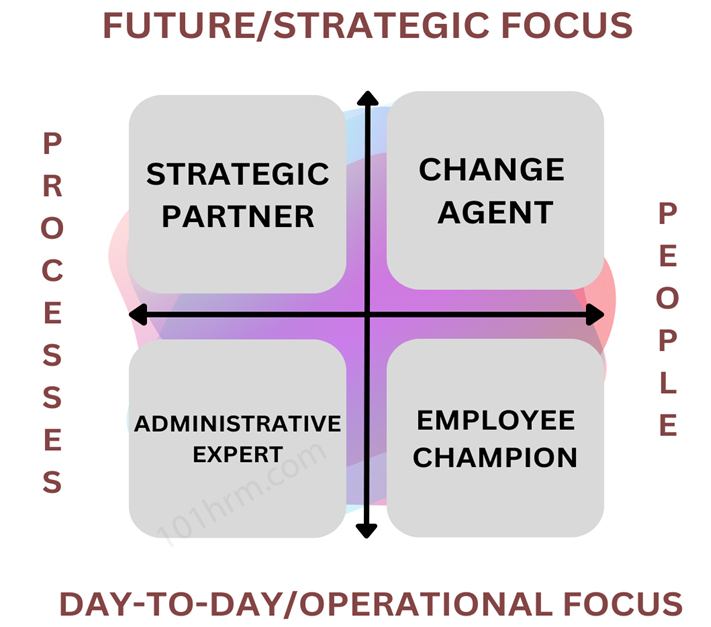Dave Ulrich HR Model: Purpose, Strengths, Weakness Explained (2023)
Dave Ulrich HR Model: Purpose, Strengths, Weakness Explained (2023): David Ulrich’s HR model is used by leading customer-centric companies around the world to improve the efficiency and effectiveness of their HR departments.
Also See: HRM Models
Ulrich’s model helps organize roles and responsibilities within HR departments by defining who is accountable for the key activities that contribute to the smooth running of an organization. So in this article we will learn Dave Ulrich HR Model: Purpose, Strengths, Weakness Explained (2023).
Dave Ulrich HR Model: Purpose, Strengths, Weakness Explained (2023)
WHO IS DAVID ULRICH?
David Ulrich was a university professor, author, lecturer, management trainer and HR manager. Born in Nevada in 1953 but raised in Oregon. Ulrich studied in Birmingham Young University before PhD. in business organization theory. In the human resources world, David Ulrich is considered a guru, although many say his theories are becoming increasingly obsolete in a modern, technology-centric world.
The principles behind his work continue to help many companies organize their HR functions in a way that optimally supports both people and processes.
Also See: Human Resource Development
WHAT IS DAVID ULRICH’S HR MODEL?

Ulrich’s HR model is a model that helps to organize roles and responsibilities in HR departments. This HR model was first introduced by David Ulrich in 1995 to organize the HR function. This model was specifically designed for large companies with large and cumbersome teams to streamline workflows and ensure each team member knows their roles and responsibilities and accountability.
Ulrich’s HR model has created transparency that has greatly improved the efficiency of HR departments in thousands of large companies and ultimately helped improve the customer experience.
Also See: Harvard Model of HRM
Splitting the workforce into four key aspects (Strategic Partner, Administration Expert, Change Agent and Employee Representative) helped define roles and responsibilities and ensured that issues such as employee protection, employee satisfaction and the future of the company were not overlooked in favor of the more traditional HR activities.
OBJECTIVES OF DAVID ULRICH HR MODEL
- To create a well-functioning and unified team structure
- To define each role in the department
- To ensure that the company performs at its best and remains competitive
- To measure performance in order to continuously improve The The
- performance model was particularly innovative because it placed a strong emphasis on talent acquisition and foresight, demonstrating that they are just as important as more traditional HR roles such as employee support and administrative duties.
Also See: Guest Model of HRM

FOUR IMPORTANT ASPECTS IN DAVID ULRICH HR MODEL
- Strategic Partner: A strategic partner helps manage workforce development and growth. They look at the customer to see what can be improved and examine systems and processes that can help meet the customer’s wants and needs more efficiently.
- Administrative Specialist: The management expert has a more internal role. You manage costs, staff and the general execution of day-to-day business as usual.
- Stockbroker: The change agent looks at the overall culture of the company and thinks about how to improve it personally and professionally. You will engage with line managers to guide and facilitate change to make the organization a better place for everyone.
- Master of Workers: Employee Champion helps employees speak up and make sure they feel heard and respected at work. They support the implementation of processes and practices that provide protection and can also help ensure that the company’s employees are happier and healthier, which is a great benefit to the organization overall.
This sets the framework for a well-functioning HR department and clarifies which roles should focus on people and processes. Within these roles, determine whether each person should be responsible for operational or strategic planning.
Also See: MICHIGAN MODEL OF HRM
IS DAVID ULRICH MODEL EFFECTIVE?
- David Ulrich’s model was introduced at a time when HR had a bad reputation and was seen as a detriment rather than an added value.
- Since then, HR has undergone a major transformation, in large part due to the Ulrich model itself, so your HR department is likely already benefiting from its influence.
- However, as a full-fledged model, it is not, and should not be, suitable for all organizations. Large companies with complex HR needs may find value in this framework, while smaller companies may have more success with other popular HR models.
Also See: Contextual And European Model Of HRM
STRENGTHS OF THE ULRICH MODEL
- Organizational Engagement – The model encourages more support from employees, which in turn brings all the benefits of a more engaged workforce, such as: Increased productivity and talent retention.
- Adaptability – Thanks to the role of change agent entrusted to the staff, the company responds better to changes, be it in terms of culture, services or strategic direction.
- Streamlined Processes – Implementing outsourcing and automation frees HR from mundane and time-consuming tasks so they can focus on helping the business achieve organizational excellence.
Also See: 5p Model Of Hrm: Meaning, Purpose With Diagram
WEAKNESS OF ULRICH’S MODEL
- Implementation time – The redesign and restructuring of human resources is a long-term process. Defining roles, finding HR talent, and creating new ways of doing things takes a lot of time, effort, and investment, and reaping the benefits of the model can take time.
- Rely on senior management approval – David Ulrich’s model only works if all senior management agrees. Managers need to change their perception of human resources and welcome them as strategic partners.
- One size does not fit all – some experts believe that the model is too rigid in structure and does not take into account the unique needs of the company.
Also See: ASTD Model Of HRM
PURPOSE OF DAVID ULRICH HR MODEL
- When Ulrich’s HR model emerged, HR departments in general weren’t as efficient and forward-thinking as they are today, and there was definitely a need to create a foundation on which to build and build a team.
- HR teams in large companies today work like well-oiled machines; both by providing everyday products that support and care for people, and by proactively looking to the future by sourcing talent, working on strategies and helping to stay ahead of the competition.
- Especially those whose HR departments find this foundation useful and can draw from it in a way that suits their organization’s unique needs.
Also See: Ethics in HRM
CONCLUSION
Ulrich’s model represents a paradigm shift in the human resources function. It is particularly suitable for large or complex organizations with multiple business areas. Ulrich’s model defines four key roles that human resources should play in an organization: strategic partner, change agent, management expert, and employee representative.
Ulrich’s model shifts the focus from a resource-hungry bureaucracy to corporate value creation. However, implementation takes time and there is some confusion as to whether the model is a project or a methodology.
Also See: Warwick Model of HRM: Meaning, Elements and Advantages
So it was all about Dave Ulrich HR Model: Purpose, Strengths, Weakness Explained (2023), if you liked this article then please share it with your friends.
Leave a Reply